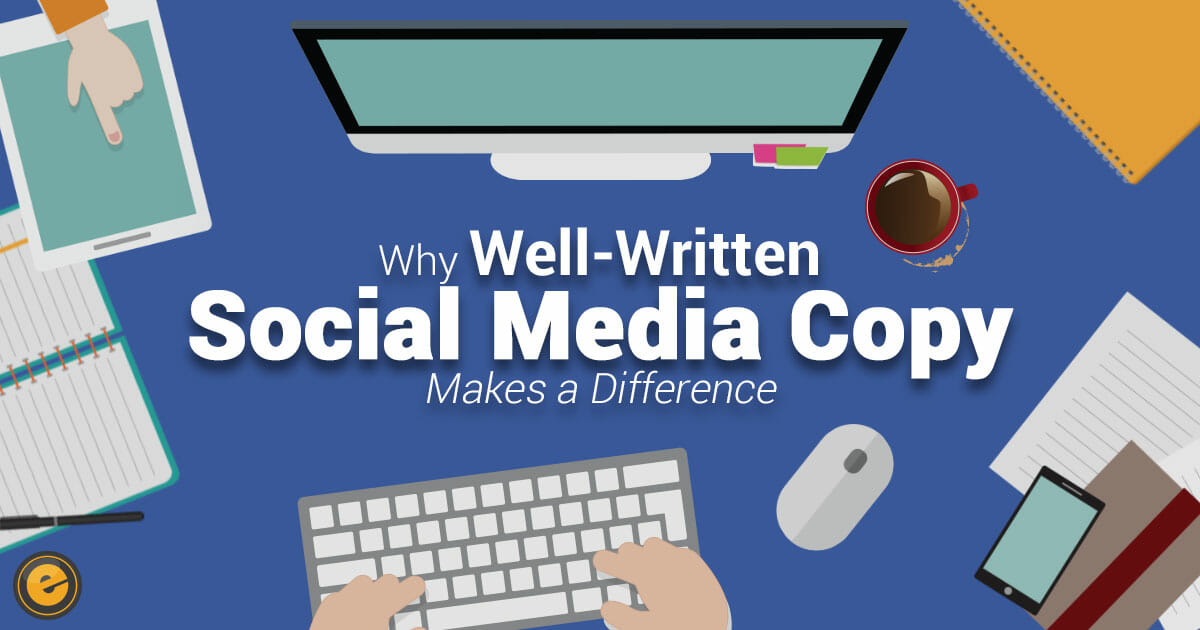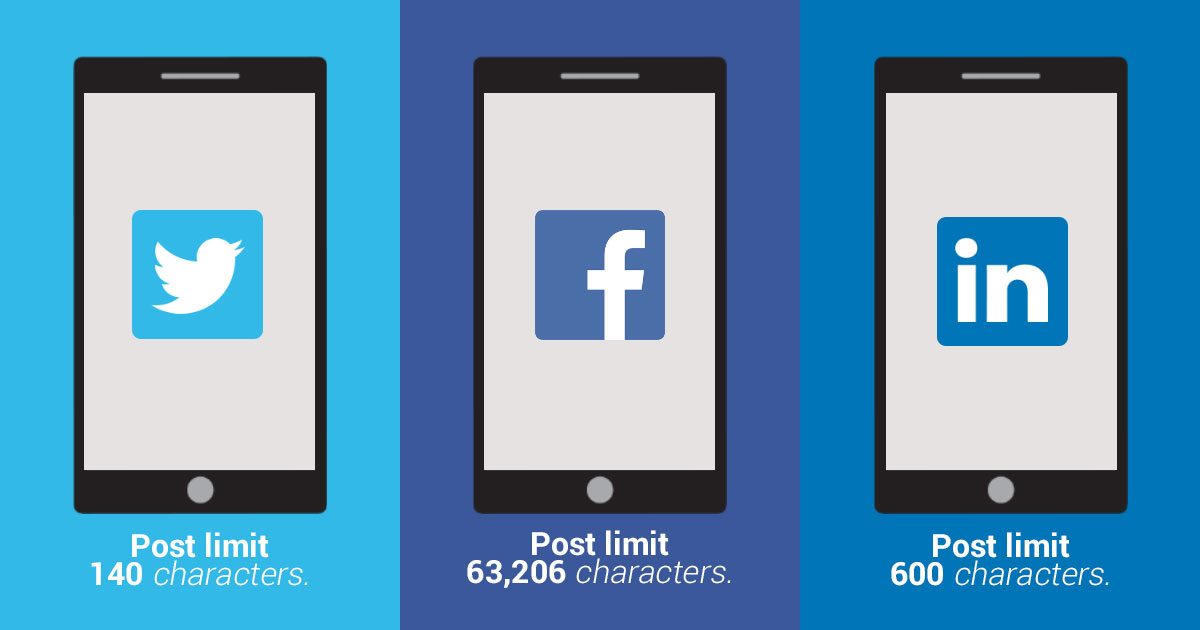To succeed in the social media sphere, businesses must populate their various accounts with consistently strong writing (in addition to strong imagery). It might surprise you to learn, however, that not all social media managers deem themselves writers.
The good news is that writing social media copy isn’t complex. Nevertheless, learning how to write for social media is worth it. Here are some tips on how to write better content for social media – and why it matters.
Why Writing Well Matters

Meanwhile, a social post that is unfocused or disorganized reflects poorly on a business, hurting any rapport the company had built with existing or potential customers. Poorly written content doesn’t do a business justice and can undermine an organization’s success. Therefore, well-written social media posts are important.
Conciseness
A successful social media writer is informative yet concise. A large amount of value has to be communicated in as few words as possible. A strong social media post compels the reader’s attention with carefully calculated word choice. In short, writing well for the internet involves learning the right style, which we’ll get to later.
Consistency
Social media writing must be consistent. A Facebook page must share the same message a connected Twitter page does. Businesses should give an even level of attention to all social media accounts (unless one platform is clearly fostering better results). If a business is raving about a 50 percent off deal on all products on Twitter but crickets are chirping on its Facebook page, then there is inconsistent communication. The only exception is if the company is pushing a platform-specific offer.
Tailoring the Message to the Platform
On the other hand, consistency in content does not mean universal writing styles for all social media websites. A Facebook post has a 63,206-character limit while Twitter allows no more than 140. A LinkedIn post is intended to be formal and informative, while a tweet’s purpose is to be eye-catching and clever.
The same style and word choice of writing will not work for all social networks, but there must be common ground regarding communicated content over all platforms. This makes mastering the art of social media copywriting all the more challenging.
How Long Can the Social Media Copy Be?
This is the wrong question. Instead of asking how long a social media post can be, you should ask how long the post should be. A tweet can be up to 140 characters, but it shouldn’t be your business’s standard to run every tweet right up until the limit.
Finding the ideal character count for a specific Twitter, Facebook or LinkedIn post may sound impossible, but thankfully, researchers have done the heavy lifting to produce ideal word count figures. Here are the findings:
- Twitter: Post limit: 140 characters. Ideal post length: 71–100 characters. Keep in mind that including any link removes 24 characters. Also, many social media experts recommend using 1–2 hashtags per tweet.
- Facebook: Post limit: 63,206 characters. Ideal post length: 40 characters. The 60,000+ character limit includes the content that stays hidden unless the user clicks “Read More.” In reality, the character limit before the “Read More” link shows up is only 400.
- LinkedIn: Post limit: 600 characters. Ideal post length: 25 words. As mentioned earlier, it’s recommended to keep your LinkedIn copy more straightforward and professional than on other platforms.
How Should Twitter, Facebook and LinkedIn Posts Be Written?
Each social media network is unique. Twitter, Facebook and LinkedIn posts have different end goals and different audiences they attempt to reach, and keywords can be specially utilized for each. Therefore, your social media copy should be tailored to fit these expectations.
Here is how the different social media networks operate, and how you can make the best use of keywords on each.
Writing for Twitter
Twitter is essentially a news platform camouflaged as social networking. There is a heavy emphasis on retweeting and content circulation. Twitter is the epitome of something “going viral.” A business that intends to share blog posts or promote website content should find Twitter to be a valuable tool.
As a rule of thumb, resharing article headlines as Twitter post copy should be used in moderation. It is best to tailor the social copy to the content an article is conveying. This entails giving a synopsis of the story or a unique insight, rather than a regurgitation of the article’s headline. In general, try to write complete sentences and clear thoughts on Twitter.
Using Twitter Hashtags and Emoji
It is a well-known rule to include hashtags at the end of a post. This will ensure they receive extra attention than they would otherwise. A healthy hashtag limit is 2–3 per post, so do not overuse them. Focus on using important keywords as your hashtags. With a high enough volume of sharing, the keywords can become successful.
In the same way hashtags should not be overused, neither should emoji. However, these icons can be beneficial addition to tweet copy when used economically because they add character to the content.
Including URLs
URLs are helpful to add to tweets. Adding them about 25 percent of the way into the tweet is better than including it at the tail end, according to research. This requires formulating a short introduction, embedding the URL, and then adding a longer explanation.
Writing for Facebook

Keywords are difficult to track through Facebook, but not impossible. You can use keywords in your Facebook status updates, and then click the “See All” option near “Insights.” This should help you quantify the number of users your keywords are reaching, and how viral these terms are.
Contrary to popular opinion, Facebook posts should be short: 40 characters short, believe it or not. Facebook also lowers promotion-heavy posts in its feed. This means posts that include phrases such as, “Act Now!” or, “Purchase Now!” should be avoided because Facebook’s algorithm will flag it. The tone of a Facebook blurb for a blog post or article should be concise, witty and conversational.
LinkedIn is a business-centric site, so a company’s content needs to appeal to this mindset. LinkedIn is the site of choice for professional content and business article sharing. As a side note, LinkedIn created LinkedIn Pulse in 2015, which is a content publishing and distribution feature.
LinkedIn writing is clear, concise and respectful. The most important rule for LinkedIn writing is remembering that a professional audience is reading the post. Avoid confusing language, get straight to the point and maintain a professional voice.
For keywords, the most important places to use them are in your location, your professional headline (120 available characters), your personalized URL, your summary of experience, and your overall profile summary. Use these spaces to advertise yourself and your business for best results.
Social Media Copy Can Make or Break Your Business
Stellar social media copy should be a weapon in every business’ arsenal. The written word powers social media (although images and video help, too). Guiding this power effectively through deft writing skills and audience reconnaissance leads to success in the social media realm.
Eminent SEO can help give your business’s social media efforts a boost – either through consulting or even taking control of your many social accounts, ensuring that each receives plenty of enticing, head-turning content every month. Click to learn more about our Social Media Marketing Services, or simply call 800.871.4130 today.






It is so important to work with a professional content writer who is genuinely skilled at their job. I have found that poorly written copy reflects extremely harshly on the business itself. It makes the business (and the owner) look disorganized, sloppy, lacking intelligence, and careless. You must seek out a professional writer if you aren’t adept at writing content so that your business is promoted optimally.
Thanks for reading, Vivian! Great input too!
Very well written article. I very like the idea: consistency. I think consistency is the mother of mastery. I saw people who post once a while and people who post every day or every week. And those individuals who post consistency make the market notice and win! Thank you for your article
Thanks for reading and for your input, Vincent! Glad you enjoyed it. Check out some of our other blog posts and let us know what you think. Happy new year!